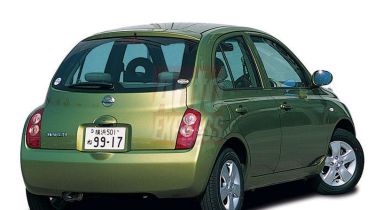Nissan Micra e-4WD
The future of four-wheel drive has changed forever. Nissan has just unveiled the world's lightest, most cost-effective 4x4 system, and fitted it to its latest supermini. The new Micra e-4WD combines the pow-er of a petrol engine with the versatility of an electric motor to provide the car with maximum grip.
THANKS to its simple, effective design, the Micra e-4WD is very impressive. The technology works, and offers real benefits to drivers. When mated to Nissan's lively 1.4-litre engine, we think the car would sell well here. And while it's not clear whether this version will come to the UK, we'll see the technology in future models.
The future of four-wheel drive has changed forever. Nissan has just unveiled the world's lightest, most cost-effective 4x4 system, and fitted it to its latest supermini. The new Micra e-4WD combines the pow-er of a petrol engine with the versatility of an electric motor to provide the car with maximum grip.
It works like this: if any wheelspin is detected when travelling on slippery roads, an electronic control unit activates a generator to power an electric motor which drives the rear wheels.
Our vehicle, powered by a 1.4-litre engine which pumps out 98bhp, was not short on acceleration, but the addition of the electric motor meant that it offered much more driver control through improved stability.
We were the first to drive the new machine at the Tochigi Fuji Industries test track in Japan, and this latest Micra was instantly impressive. Floor the throttle and the e-4WD system responds immediately. The car transfers power to the rear wheels almost as soon as you hit the right pedal, giving lag-free all-wheel-drive traction.
Used - available now

2023 Ford
Focus
31,507 milesAutomaticPetrol1.0L
Cash £16,500
2020 Suzuki
Vitara
53,047 milesManualPetrol1.4L
Cash £11,800
2023 Hyundai
Kona Electric
20,175 milesAutomaticElectric
Cash £11,200
2025 Suzuki
S-Cross
26,083 milesManualPetrol1.4L
Cash £12,700On really treacherous roads, the front tyres spin gently before the system intervenes, cutting power for a split-second as the car works out how to channel its output most efficiently.
The beauty of the e-4WD arrangement compared to other all-wheel-drive units is that it only engages if grip is lost at low speeds. On top of this, the system doesn't require a rear differential, or even a heavy propshaft, only a lightweight electric motor.
On motorways, the Micra automatically disengages its 4x4 system and - in order to save fuel - runs on the engine-driven front wheels. What's even more impressive is the simplicity of the Micra's design. The electric motor and its sensors add merely 80kg to the car's overall weight (up from 950 to 1,030kg).
As a result, the only modifications engineers made to the chassis and body (in addition to the motor and drive units) was the location of the ex-haust and the angle of the rear dampers, which are pushed more upright.
That means on winding roads the vehicle feels identical to the standard Micra we drove in Issue 696. Steering is light but precise, and the suspension is supple, offering lots of comfort over bumpy surfaces. Both cars also feature a well equipped and stylish interior.
Nissan would not confirm plans to export the e-4WD, but it did say such systems would appear on the new Cube and other sub-2.0-litre models destined for the UK next year. It looks as if we won't have to wait long to get a taste of the future!



